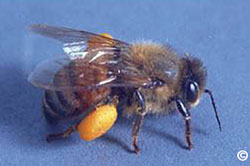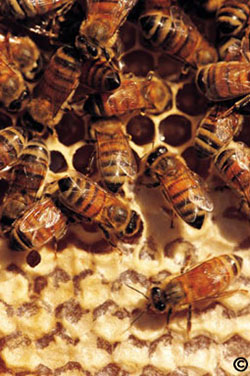Most bees and wasps are beneficial insects. Honeybees produce valuable honey, wax, and pollinate many Colorado crops. Unfortunately, both bees and wasps may sting humans when defending themselves or their nests. When honeybee swarms establish themselves in a building or home, they can be very difficult to control.
 Honeybee colonies are more likely to nest in a home or building than other bees or wasps. In the spring, honeybee colonies become too large and individuals will leave the existing colony. They have a brief mating flight and the new queen returns to the original colony, forcing the old queen to leave. The old queen leaves the hive with a swarm of workers and locates a new nest site to start a new colony. This swarm often selects homes and buildings. The honeybees enter openings in siding, entrances to attics, chimneys and other open spots in the home.
Honeybee colonies are more likely to nest in a home or building than other bees or wasps. In the spring, honeybee colonies become too large and individuals will leave the existing colony. They have a brief mating flight and the new queen returns to the original colony, forcing the old queen to leave. The old queen leaves the hive with a swarm of workers and locates a new nest site to start a new colony. This swarm often selects homes and buildings. The honeybees enter openings in siding, entrances to attics, chimneys and other open spots in the home.
 The quicker the building owner notices the presence of honeybees, the better chance they have to manage the problem. Colonies that are well established in a building are very difficult to remove. Usually the bees need to be controlled within the first month to six weeks after establishment to avoid significant cost. In an established colony, the wax and honey must be removed otherwise there will be further pest problems, odors, and staining. It is very difficult for building owners to control swarms and a professional pest control service is a safer and more efficient control strategy.
The quicker the building owner notices the presence of honeybees, the better chance they have to manage the problem. Colonies that are well established in a building are very difficult to remove. Usually the bees need to be controlled within the first month to six weeks after establishment to avoid significant cost. In an established colony, the wax and honey must be removed otherwise there will be further pest problems, odors, and staining. It is very difficult for building owners to control swarms and a professional pest control service is a safer and more efficient control strategy.
Local beekeepers will collect swarms if they are not established in a building. If established, beekeepers may not want to remove the swarms or, if they will, would likely charge a fee due to the large amount of work involved. Also, wild honeybees sometimes carry disease and may be of no value to beekeepers.
The following steps should be followed in order to control honeybees in buildings:
- Locate the swarm or nest – you may be able to feel the heat generated by the colony through the wall, may notice bee activity around the building, or hear the bees inside the wall.
- Use an insecticide to kill the bees – resmethrin or pyrethrins. This is a job best suited for a pest control company.
- If you plan to control the bees yourself, wear protective equipment and wait until the bees are less active in the morning or evening hours.
- Seal entrance holes after treatment to prevent reinfestation.
For more information, see the following Colorado State University Extension fact sheet(s).
For more information, see the following Planttalk Colorado™ script(s).



